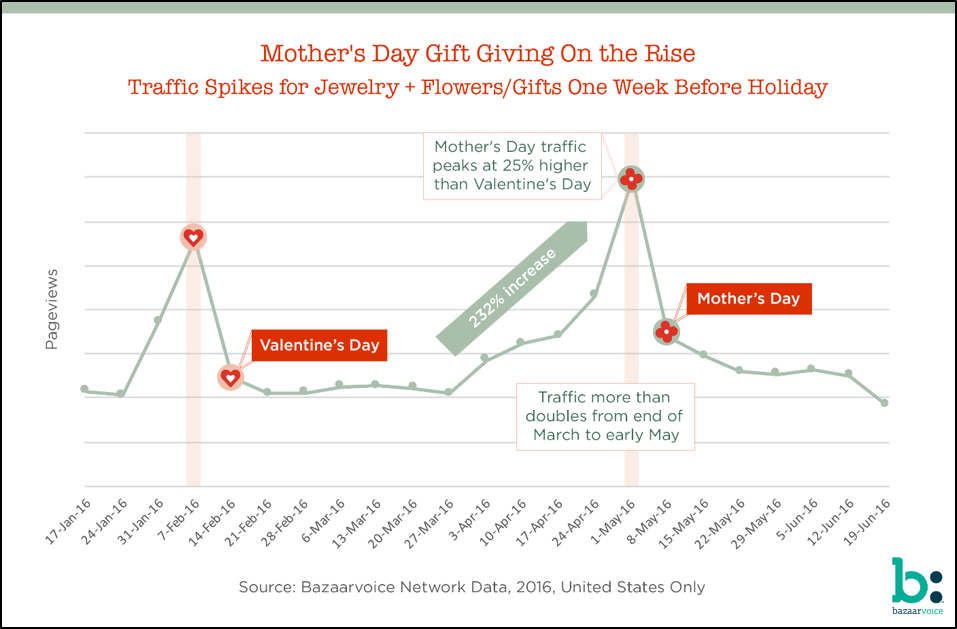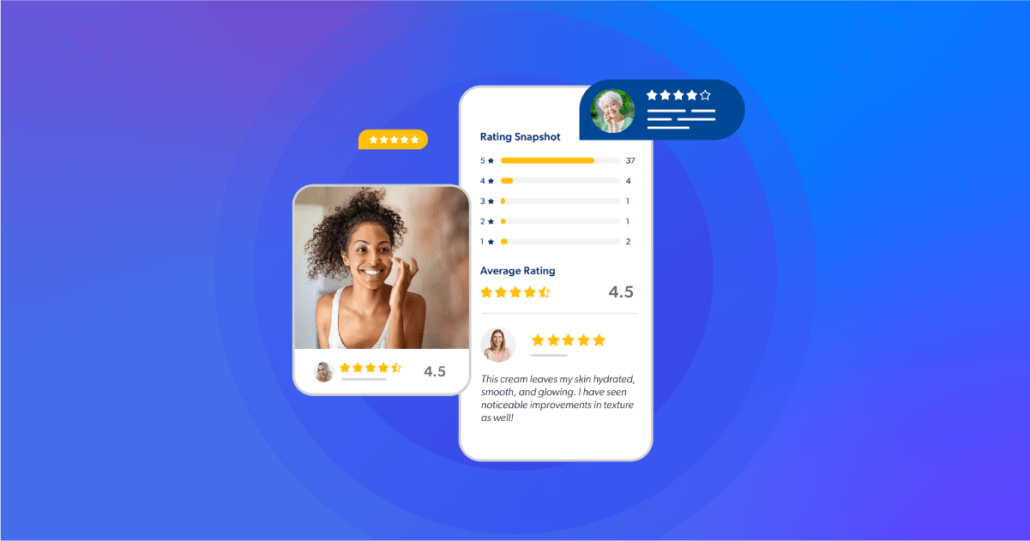May 8, 2017
At Bazaarvoice, we frequently analyze shopping activity occurring on our network to surface trends and insights that can help our clients prepare for and get the most out of busy shopping seasons. This spring, we looked at pageview traffic in the jewelry and flowers/gifts categories from 2016. We wanted to see how pageview traffic was impacted by two special occasions when people usually purchase these types of products — Valentine’s Day and Mother’s Day.
While it may seem obvious that pageview traffic for certain products spikes before holidays and special occasions, businesses should still keep these shopping patterns in mind when developing their marketing plans.

Below are three ways companies can maximize consideration and capture shoppers during spring’s seasonal surges — and keep the momentum going all year long.
1. Understand your audience.
According to our data from 2016, we found that Mother’s Day traffic peaked 25% higher than Valentine’s Day traffic. At first glance, you might think that there is finally data to support the theory that your mother truly is the most important woman in your life. But before you assume that Mother’s Day is a more popular holiday for gift-giving, take a step back — there are several possible scenarios that could account for the higher amount of site traffic.
One assumption we can make is that it is predominantly men who buy jewelry and flowers for their significant others for Valentine’s Day, while both men and women buy gifts for their mothers in May. Another reason for the higher traffic before Mother’s Day could be that many shoppers buy gifts for multiple mothers in their lives on Mother’s Day. For example, one shopper might buy flowers for his wife, his mother, and his grandmother on Mother’s Day, whereas he would exclusively buy gifts for his wife on Valentine’s Day. It’s also common for parents to buy Mother’s Day gifts on behalf of their young children. So, not only is there a larger, more diverse pool of people shopping for flowers and gifts before Mother’s Day, there’s also a high likelihood that shoppers are giving a larger share-of-wallet to brands and retailers as well.
Based on these nuances, companies should avoid using a “one size fits all” mentality when advertising their products. Though the products being purchased for these two occasions could be the same, the people purchasing them and the amount they spend can vary greatly. If you retarget the same shoppers who purchased gifts during Valentine’s Day with the same advertising leading up to Mother’s Day, you risk missing out on a large group of consumers who are in-market to buy your products. Companies must understand the different audience segments shopping for their products and adjust their marketing messaging, ad placements, and promotional offers accordingly.
2. Timing is everything.
Our network data also revealed insights about the timelines for peak shopping spikes. Last-minute shoppers accounted for the traffic spike during the week leading up to Valentine’s Day, and the same trend occurred the week before Mother’s Day. However, you will also notice that the increase in traffic is much steeper in February than in April and May. Our data indicates that people began shopping for Valentine’s Day gifts just two weeks before the holiday, while shopping gradually doubled over the five-week timeframe leading up to Mother’s Day. But why is that?
One reason could be that brands and retailers only have a month and a half between Christmas and Valentine’s Day to shift from their holiday marketing campaigns and promotions to their Valentine’s marketing efforts. Or, perhaps, since many Mother’s Day shoppers buy gifts for multiple women, they might start shopping earlier to budget for spending more.
Brands and retailers should analyze and account for these variations when timing their ad campaigns and media buys. If traffic in the flowers and jewelry categories begins to climb earlier in the spring season, running longer marketing campaigns and promotions can help you capture the attention of more shoppers, not just the last-minute ones.
3. Think outside the box.
Though it’s typical and expected for brands and retailers in the flower and jewelry categories to experience the highest peaks in site traffic during the Valentine’s and Mother’s Day timeframes, businesses should think about creative new ways to capitalize on slower sales cycles throughout the year. Be resourceful and original in your timing, promotions, and messaging to give your business a huge competitive advantage during “off-seasons” when your competitors may not be paying as much attention.
One way to market creatively is to simply listen to your customers. Pay attention to customer feedback, read ratings and reviews about your products, and monitor what consumers are sharing on social media to get insights about who’s buying your products and why they’re buying them. You might uncover a unique opportunity that your competitors often neglect or forget about. For instance, a flower vendor may discover that parents often buy their children flowers for graduation or after dance and musical recitals. Incorporating real-life testimonials or visual content around these lower profile, yet still meaningful moments in your ad creative can be an effective way to tell a fresh, new story that resonates with different audiences you might not have targeted before.
Companies should also personalize marketing to generate repeat business. We’ve learned that 54% of consumers want more personalized shopping experiences based on their browsing and buying behavior, including savings and rewards based on past purchases. Imagine if a jeweler or florist could remind husbands when their wedding anniversaries or wives’ birthdays were just around the corner! Targeting those shoppers with compelling and relevant offers at the right time could turn a one-time shopper into a long-term customer.
Examining seasonal shopping trends over time can help companies plan and prepare for upswings in site traffic and sales. But marketers who dive into the data to understand who their customers are, time their campaigns thoughtfully, and identify creative and unique opportunities to market to different people can break through the noise and maximize their sales during both high-traffic and slow sales cycles.





